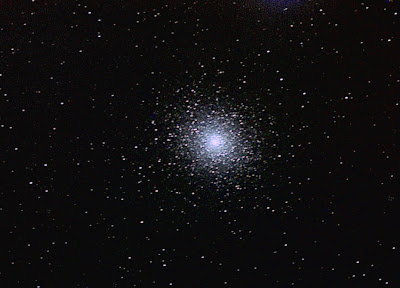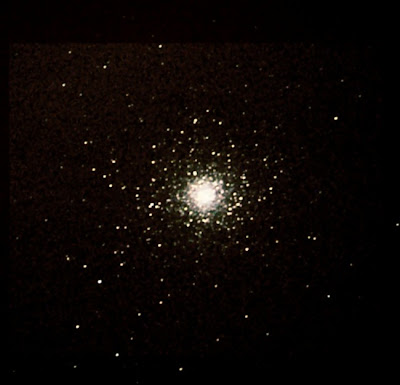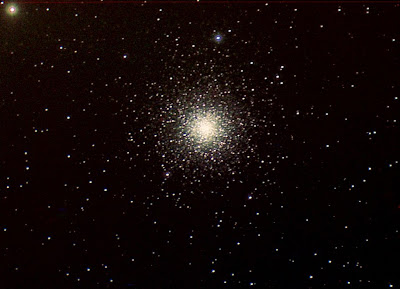 Click on image to enlarge.
Click on image to enlarge. Object: Messier 5 (NGC 5904)
Type: Globular Cluster
Distance: 24,500 light years
Distance: 24,500 light years
Constellation: Serpens
Date: 26 May 2009
Equipment: SXV-H9, Vixen ED 114mm aperture f5.3 refractor, ATIK manual filter wheel, Astronomix LRGB filters
Subframes: 20 x 60 seconds luminance (2x2 binned), 12 X 40 seconds each for red, green and blue channels, 16 flats/flat darks in luminance only, calibrated and stacked in AIP4Win, tweaked in AstroArt and PSP7.
From the same evening as the previous shot. As I started to image this at about 1.30 in the morning, M5 was already at only about 30° altitude and was starting to sink into the yellow fog of my western horizon.
Not surprisingly, it appeared a lot dimmer on the monitor screen than M3, even though in reality it's around half a magnitude brighter. This is definitely an object I need to revisit earlier in the evening to do it justice!
I was surprised at how blue this came up, even though it was processed in a pretty similar way to my earlier shot of M3. I don't know if that's just an effect of having to stretch the raws that much more to get rid of sky-glow.
With reference to my previous equipment glitch, David "Astroeyes" Moth (of galaxy imaging fame over on the UK SPA gallery site) has also had experience of SS2K crankiness. The connector between the handset and drives is definitely a piece of junk and lets the superb handset down. Both David and I have had the drive act randomly, and I have found I need to be careful not to have the connector under any sort of flexure. SS2K really is a wonderfully easy and powerful GoTo system and it's a shame that Vixen have superseded it with their SkyBook, which I don't care so much for. With SS2K, all the functionality is built in, without having to muck about with downloads, although I will admit things might have improved since I played with an early version.
As for my recent drive problem, I will have a look at the unit encoder - the behaviour does seem like the sort of thing that dust in an encoder might do.
Anyway.
Here's an earlier shot of M5 I took back in 2002:
Equipment: SXV-H9, Vixen ED 114mm aperture f5.3 refractor, ATIK manual filter wheel, Astronomix LRGB filters
Subframes: 20 x 60 seconds luminance (2x2 binned), 12 X 40 seconds each for red, green and blue channels, 16 flats/flat darks in luminance only, calibrated and stacked in AIP4Win, tweaked in AstroArt and PSP7.
From the same evening as the previous shot. As I started to image this at about 1.30 in the morning, M5 was already at only about 30° altitude and was starting to sink into the yellow fog of my western horizon.
Not surprisingly, it appeared a lot dimmer on the monitor screen than M3, even though in reality it's around half a magnitude brighter. This is definitely an object I need to revisit earlier in the evening to do it justice!
I was surprised at how blue this came up, even though it was processed in a pretty similar way to my earlier shot of M3. I don't know if that's just an effect of having to stretch the raws that much more to get rid of sky-glow.
With reference to my previous equipment glitch, David "Astroeyes" Moth (of galaxy imaging fame over on the UK SPA gallery site) has also had experience of SS2K crankiness. The connector between the handset and drives is definitely a piece of junk and lets the superb handset down. Both David and I have had the drive act randomly, and I have found I need to be careful not to have the connector under any sort of flexure. SS2K really is a wonderfully easy and powerful GoTo system and it's a shame that Vixen have superseded it with their SkyBook, which I don't care so much for. With SS2K, all the functionality is built in, without having to muck about with downloads, although I will admit things might have improved since I played with an early version.
As for my recent drive problem, I will have a look at the unit encoder - the behaviour does seem like the sort of thing that dust in an encoder might do.
Anyway.
Here's an earlier shot of M5 I took back in 2002:

This was a single afocal frame using a Casio QV-3500Ex and my Vixen VC200L, which actually gives a good impression of what it looks like visually with the same scope under a good dark sky (of the sort I might get once every year if I'm lucky). As with M3, it comes up greenish, although Rob Gendler's work gives a blue colour similar to the one I obtained with the SXV-H9.




